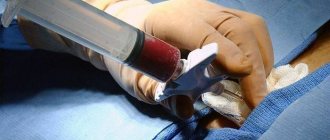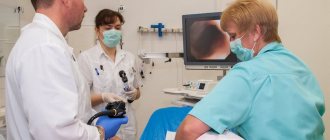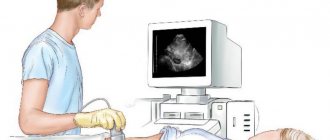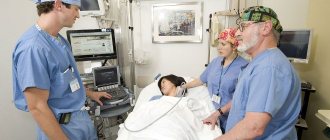Laparotomy or laparoscopy
Abdominal laparotomy and popular laparoscopy have their advantages, but each operation also has a disadvantage. For those who do not know what laparoscopy is, it should be noted that it is a surgical procedure, but it does not require any incisions to be made in the abdomen. It is enough to make 2-3 minor punctures through which instruments and a video camera are inserted into the abdominal cavity. Under these conditions, the doctor performs microsurgical manipulations.
Despite the significant advantages of laparoscopy, patients are often prescribed laparotomy surgery. It has differences that are its advantage:
- Technical simplicity of the operation.
- No complex equipment required.
- This surgical procedure is convenient for the surgeon.
Laparoscopic surgery: general information
Laparoscopy is a type of operation in which several punctures are made in the abdomen and long manipulators are inserted through them. In turn, a camera is inserted through the incision above the navel, through which the surgeon can see his actions. It is characterized by low trauma, but a much slower doctor’s response in case of complications.
Indications for laparotomy
Not everyone has indications for laparotomy. A similar operation is prescribed in the following situations:
- ovarian cyst rupture
- ectopic pregnancy,
- purulent inflammation of the fallopian tube or ovaries,
- peritonitis,
- development of tumors of the reproductive organs,
- ovarian dysplasia,
- tubo-peritoneal infertility.
As a rule, for women who go to the doctor with complaints of pain in the lower abdomen, it is not difficult to make a diagnosis. For this purpose, standard tests and ultrasound are prescribed. But sometimes a detailed examination is required to clarify the diagnosis. For example, the surgeon may need to determine the location of a sudden ulcer rupture or determine the cause of internal bleeding or find a node. Exploratory laparotomy is an opportunity to determine the exact cause of the patient’s complaints and prescribe appropriate treatment. Anesthesia is required for such an intervention.
Types of operations and deadlines
Surgery divides operations according to the timing of their implementation into 3 types:
Emergency (urgent). Such operations are carried out immediately after the patient’s admission to the hospital department. The time to prepare for the operation is minimal, every action of the doctor is aimed at saving lives.
Urgent. Such operations are performed urgently, but usually require several hours to prepare the operating room and make an accurate diagnosis.
Planned. The operation is proceeding as planned and on time. The duration of such an operation can stretch for several weeks, which allows you to confirm the diagnosis and pass all possible tests.
Types of laparotomy
Laparotomy can be performed in several ways. Types of laparotomy:
Pfannenstiel laparotomy
- Laparotomy according to Cherny. This type involves making an incision along the line exactly between the pubic bone and the navel. The so-called Cherny laparotomy involves transverse interiliac transection. This method is used for tumor pathologies, for example, if uterine fibroids have developed. The advantage of this method is that the surgeon can expand the incision lines at any time convenient for him and access to organs and tissues will be increased.
- Laparotomy according to Pfannenstiel. The preferred method used in gynecology. Transverse suprapubic transection is assumed. The incision will be along the lower line of the abdomen. The scar remaining along the incision line will not be noticeable.
- Laparotomy according to Joel-Cohen. It involves making a transverse incision made 2-3 cm below the middle of the distance between the navel and pubis. Implementing such mini-access is very convenient.
What are the risks of abdominal surgery?
Abdominal surgeries are performed in all hospitals in the post-Soviet space. The disadvantages of this method are, first of all, long recovery. Increased trauma leads to long healing of damaged tissues and, most often, the appearance of a scar, which has an extremely negative impact on the self-esteem of one’s appearance (especially for women).
A long postoperative period leads to large additional material costs. This means staying on sick leave and purchasing the necessary medications for the speedy healing of the wound. But the advantage of such an operation is that it can be performed in a clinic of any level. Whereas laparoscopy should be performed using high-quality equipment only by confident professionals who know how to work with ultra-sensitive equipment.
There is a method of minilaparoscopy or microlaparoscopy, when the procedure is carried out with devices 2-3 mm thick. The hospitalization of the patient lasts a day, and stitches are not required.
Preparing for surgery
Surgery requires preparation. The doctor must collect as much necessary information about the patient as possible. That is why a woman should answer the doctor’s questions as accurately as possible. This applies, at a minimum, to lifestyle, harmful addictions, medication and diet.
After laparotomy, the doctor directs the patient to the fact that some procedures will definitely need to be completed, and also expresses his predictions regarding the period after surgery.
The anesthesiologist who will administer the anesthesia must also ensure that the patient is ready for surgery.
General criteria
Both access through an incision (cavity, which is also called laparotomy), and access with manipulators through small holes in the patient’s abdomen (laparoscopy) are performed exclusively for surgical indications . Both methods of access are aimed at allowing the surgeon to do his job with the highest quality.
Both do not cancel the mandatory postoperative rehabilitation period for the patient. In both cases, organs can be removed (but with laparoscopic access it becomes somewhat more difficult to remove them). Also, one method can flow into another: for example, there are operations in which most of the process is performed laparoscopically, while the final part is performed laparotomically . An example of such surgical interventions would be a right hemicolectomy, when half of the colon is removed (for example, for a tumor disease).
Also, if complications develop, the surgeon can easily switch from laparoscopy to laparotomy (abdominal surgery), since the beauty of the sutures and minimal trauma lose in the battle with such a factor as the patient’s life. For example, this can happen if a large artery is accidentally damaged.
Laparotomy, features of the operation
To begin with, anesthesia is administered. As a rule, all abdominal operations, and laparotomy is no exception, are performed after general anesthesia has been administered. The surgical technique is as follows:
- Using a scalpel, the skin and subcutaneous fat are cut. After the incision has occurred, the resulting wound should be drained. Using a coagulator helps stop bleeding quickly and safely. Only after the blood vessels are clamped can the next stage of the operation begin.
- Using a special set of instruments for laparotomy (hooks), the edges of the incision are separated and the surgeon can begin to dissect the aponeurosis. Sometimes it is necessary to separate the edges of the muscles that block the doctor’s view.
- Then the peritoneum is dissected using special scissors. If fluid has accumulated in the cavity, the surgeon's assistant removes it using a special suction.
- After dissecting all layers and removing excess fluid, the edges of the wound are spread apart using expanders and the doctor performs a thorough examination of all organs. Even if the surgeon knows exactly what the problem is, he still must evaluate every organ that comes into his field of vision.
- After this, the operation itself is performed, as a result of which the pathology is eliminated and the patient’s condition is normalized. If this cannot be achieved, the organ should be removed.
- Upon completion, drains are installed and the incised areas are sutured in layers.
As soon as the anesthesia wears off, the patient will regain consciousness.
Operations through the vaginal genital tract
Hysteroscopy and separate diagnostic curettage of the walls of the uterine cavity and cervical canal. During the procedure, an optical device (hysteroscope) is inserted into the uterine cavity through the vagina. A camera is attached to the hysteroscope, images from which are displayed enlarged on the monitor. This way, the doctor can not only visually assess the condition of the tissues, but also, if necessary, enlarge the picture and carefully examine suspicious areas and take tissue samples.
This surgical procedure is indicated for the diagnosis and treatment of many gynecological conditions, such as endometrial polyposis, uterine fibroids, uterine endometriosis, glandular cystic endometrial hyperplasia, cervical cancer, etc. During the procedure, endometrial scrapings are taken separately from the cavity and the cervix is sent to histological examination, which allows us to determine the cause of the pathology.
Using this method allows you to remove endometrial polyps, dissect adhesions, perform a medical abortion, etc.
Another hot topic that was previously considered a common characteristic of “old age” is prolapse (drooping or loss) of the female genital organs. Pelvic floor and pelvic organ prolapse syndrome is a common problem for women of all age groups. Its incidence is about 20% in women under 50 years of age and more than 50% in postmenopausal women (after the cessation of menstrual function). Women suffering from this pathology often suffer from the problem of urinary incontinence, constant irritation in the perineal area, do not know what to do, and are afraid that it will get worse. But this is a completely fixable situation. It is important to understand that the earlier the operation is performed, the easier the postoperative period. Considering that this disease is still inherent in women of an older age group, preoperative examination and phasing in performing operations are especially important here. Sometimes this is only vaginal plastic surgery, sometimes it is uterine fixation and pelvic floor plastic surgery.
Complex surgical treatment of patients with pelvic prolapse makes it possible to eliminate all existing anatomical defects of the pelvic floor and associated diseases of the pelvic organs, which improves the functional results of treatment in this category of patients, reduces the frequency of relapses of the disease and the number of repeated visits of patients for this pathology.
In the younger group, it is important to restore the vagina and perineum after traumatic births, repeated births, when prolapse has not yet formed, but intimate discomfort is already present. Another popular operation is plastic correction, including plastic surgery of the labia.
Recovery after surgery
To ensure that a woman does not encounter complications or undesirable consequences after surgery, and that her recovery is faster, she needs to follow certain instructions prescribed by the doctor.
While in the hospital, the patient must:
- follow all doctor's orders,
- use special shoes to reduce the risk of blood clots,
- Often (though not always) it is necessary to urinate through a special catheter.
- in severe situations, a special incentive spirometer can be used to improve breathing.
Important! The patient is prohibited from independently examining the wound, removing bandages, or touching drains. There is a high chance that an infection may occur.
How long a woman will stay in the hospital depends on the characteristics of the disease for which the surgical intervention was performed. If the patient goes home soon after the operation, she must also adhere to certain rules:
- follow all doctor’s instructions, including regarding the timing of hospital visits,
- maintain maximum hygiene in the wound area,
- water should not get into the postoperative suture site,
- reduce the amount of physical activity to a minimum,
- Do not lift heavy objects under any circumstances, as the seams may come apart,
- A diet of predominantly fruits and vegetables must be followed.
Usually 5-7 days after surgery the sutures are removed. However, after this you need to be extremely careful about your condition. If you notice a number of symptoms, you should immediately consult a doctor:
- in case of elevated temperature,
- if inflammation or strange discharge appears in the operation area,
- bowel dysfunction that lasts for 2-3 days,
- the chair has changed its properties (for example, color),
- general condition worsened (weakness, dizziness appeared),
- nausea, vomiting,
- problems with urination,
- swelling appeared, which is in no hurry to subside, redness, pain in the legs.
A laparotomy operation performed with the symptoms described above is evidence of complications.
Many patients are afraid that the stitches may come apart. They should not diverge if you follow all the doctor’s recommendations. However, every patient should know the answer to the question of what to do if the suture suddenly breaks after surgery.
In this case, the main thing is not to panic. Examine the wound, incision lines and call an ambulance immediately. While you wait, the edges of the wound can be covered with a bandage to stop further dehiscence.
Postoperative period
In the first days after surgery, the patient remains under the supervision of specialists until the sutures are removed. Typically, the early postoperative period in the hospital lasts 7-10 days. After which, provided there are no complications, the patient is discharged. At home, a person will have to:
- adhere to the correct regime and diet;
- maintain an orthopedic regimen;
- wear a postoperative bandage to avoid the development of a hernia;
- adjust physical activity;
- avoid heavy lifting;
- during the first month you cannot visit the bathhouse, sauna, swimming pool, or swim in open water;
- after abdominal surgery in gynecology, it is necessary to exclude intimacy for a period of 1-2 months.
The duration of the postoperative period is determined by the disease for which abdominal surgery was performed. The speed of recovery is influenced by the accuracy of compliance with medical recommendations.
Possible complications
Laparotomy in gynecology can result in complications under certain circumstances. For example, when performing an operation on the uterus, the possibility of damage to neighboring organs cannot be ruled out. The laparotomy procedure being performed increases the risk of adhesions. This happens due to the fact that in the process of performing surgical actions, the instruments have to touch the peritoneum, as a result an inflammatory process can begin and adhesions appear on the peritoneum, “gluing” the organs together.
A serious complication is bleeding, which can be caused by various reasons.
Microsurgical operation for varicocele
Laparoscopic surgery for varicocele is the leading method of treating varicose veins of the spermatic cord. A minimally invasive technique for performing varicocele surgery using an endovideo camera allows, under high magnification of the internal organs, to isolate and ligate the necessary veins without causing injury to the artery and lymphatic vessels.
back to Laparoscopy in cats. Modern approach. >>>
Complications such as inevitable cesarean section after removal of uterine fibroids, uterine rupture along the scar after laparoscopy occur extremely rarely, especially if the operation was performed by an experienced surgeon.
However, feedback from women is not always positive. Even abroad, doctors are not always able to preserve the uterus after laparoscopy. But since fibroids are a dangerous disease that can threaten not only reproductive function, but also the life of the patient, the impossibility of natural pregnancy should not put an end to a woman’s desire to have offspring. IVF with surrogacy can be a solution for such patients.
Cost of the operation
The price of laparoscopy for uterine fibroids in Moscow can vary dramatically depending on the prestige of the clinic, its proximity to the center, the complexity of the operation, and the qualifications of the surgeon. The cost of the procedure can range from 28,000 rubles. up to 38,000-40,000 rub. and more (up to 70,000 rubles). On average, the price of an operation does not exceed 50,000 rubles.
Thus, the advantages of laparoscopy over laparotomy or conventional abdominal surgery are obvious.
The advantages of laparoscopy over abdominal surgery appeared quite quickly after the start of this new type of surgery. One of the most important is the absence of an incision in the anterior abdominal wall, which hurts for a long time and takes a long time to heal after the operation, which is why the woman is forced to stay in the hospital for 10-15 days. Already 2-3 hours after laparoscopy, the patient begins to get up. Usually, by the evening or morning of the next day, the condition allows you to return to normal physical activity, and after 2-3 days to return to work. Marks on the skin from punctures heal quickly enough and after a few months they can be detected only if you know where they were.
In addition, the technology of laparoscopy, in which an image from the abdominal cavity is displayed on a monitor screen, allows us to examine the smallest pathology that is not visible during classical surgery. This is possible due to the fact that the monitor can enlarge the image of organs up to 10 times, which allows not only to see foci of pathology, but also to remove them in the most delicate and gentle way, without affecting healthy tissue.
In general, there is nothing terrible there!
Placebo effect
I think that everyone has heard this phrase at least once in their life. Translated from Latin, “placebo” literally translates as “I will please, please.” So you have to like it by definition? Not exactly, but you shouldn’t underestimate him either. Write in our Telegram chat how you feel about this phenomenon. There are doctors there. It will be interesting to discuss.
One tablet with medicine, the other without. Which one will you choose?
Recently, many people believe that this should not work, but the famous effect continues to work. There are only two areas in which the effect does not apply. The first is heart disease, since experiments can end badly. Also, placebos are not used for joint diseases, since they cannot be forgotten. If it hurts when you move, it hurts. The brain will not be able to abstract from this.
In other areas, experiments even go so far as to stage a “performance” in front of the patient, as if he was undergoing surgery. For realism, they even make an incision. After which his condition is monitored. The result of such “operations” is often complete recovery. As a result, we can say that our body works miracles when it believes in them.
Heroes of “Pulp Fiction”
One of the most famous moments in Quentin Tarantino's cult film Pulp Fiction is the one in which Vincent (John Travolta) injects Mia (Uma Thurman) with adrenaline after an overdose. According to the plot, he comes to a friend who knows what to do and, having outlined a goal, gives Vincent a syringe. After that, he swings and hits the target with force with the syringe.
This is roughly how they give an injection of adrenaline into the heart.
Many people think that this is fiction, however, the filmmakers very realistically showed how an adrenaline injection is given to the heart. The only flaw was that the characters spent a lot of time talking. It was better at this moment to do an indirect cardiac massage.
Otherwise, everything happens exactly like this. To inject into the heart, you need to pierce a lot of tissue, and this is not so easy to do.
The progress of laparoscopy and its advantages
Laparoscopy, as well as laparotomy, will be performed under general anesthesia. Most often this is endotracheal anesthesia, which is combined with intravenous anesthesia. An hour before being sent to the operating table, the patient is given premedication to facilitate anesthesia and prevent some complications.
After the patient falls asleep, 2-3 small incisions or punctures are made in the abdominal wall - they ensure free insertion of the necessary instrument. Next, gas is pumped inside to increase the volume of the cavity and ensure free manipulation of thin instruments without the risk of damaging nearby internal organs.
The main advantages of such an intervention are rapid recovery and a minimum of possible postoperative complications. All preparation is carried out on an outpatient basis. The patient is hospitalized 1-2 days before the day of surgery. A definite advantage for many people was the psychological aspect - it is easier to decide on a low-traumatic intervention, which helps reduce the number of advanced cases.
Surgeons are not happy about the pulled bullet
Sometimes in movies they show how the surgeon tensely picks at the wound, afraid to make an unnecessary movement, after which he removes the bullet and exhales in a relaxed manner. Sometimes they even show how happy they are after this. It looks like the job is done and you can relax.
The deadly beauty of a piece of metal
In real life this is an important point, but it is still only at the very beginning of the operation. After this, you need to treat the wound, check for organ damage, stitch everything up and carry out restorative procedures. Surgeons are not happy that the knife did not remain in the wound... It’s the same here. Removing the bullet is just the beginning; the most important thing is to stop the loss of blood and eliminate the consequences of the wound.
It is also a myth that a bullet falls into a bowl with a characteristic ringing sound. Plastic waste trays are often used now. Therefore, such a sound simply cannot exist. But it looks impressive.
Just a funny picture to lighten the topic a little
Why doesn't everyone recommend laparoscopic surgery?
Of course, after these positive qualities, few will doubt which operation is better: abdominal or laparoscopy for the patient. But when comparing, complications that are acceptable in medical practice cannot be excluded when laparoscopic surgery is performed. So, as with conventional manipulations, there is a risk of damage to blood vessels, nerves, and organs. With major bleeding, the surgeon has no view, and stopping the bleeding becomes more difficult. A bloated stomach creates some discomfort, but cannot harm a person, with the exception of painful sprains. Over time, the phenomenon passes through intercellular metabolism.
If we are talking about whether abdominal surgery or laparoscopy is better when removing the uterus, then we need to consider all the options, consequences, and risks for the patient.











